Poland
2000
"Prehistoric animals: Dinosaurs"
| Issue Date |
24.03.2000 |
| ID |
Michel: 3811-3816, BL. 139
Scott: 3503-3508 Stanley Gibbons:
3843-3848 Yvert: 3586-3591 UPU: N/A
Category: pR |
| Author |
Designer: Jacek Brodowski |
| Stamps in set |
6 |
| Value |
PLN 0.70 - Saurolophus
PLN 0.70 - Gallimimus
PLN 0.80 - Saichania
PLN 0.80 - Protoceratops
PLN 1.55 - Prenocephale
PLN 1.55 - Velociraptor |
| Size (width x height) |
51 x 31.25 mm |
| Layout |
20 stamps in sheet |
| Products |
FDC x 3 MS
x 1 |
| Paper |
fluorescent |
| Perforation |
11x11,5 |
| Print Technique |
Offset, multicolor |
| Printed by |
|
| Quantity |
2 x 2,700,000 pcs
2 x 2,700,000 pcs.
2 x 1,700,000 pcs. |
| Issuing Authority |
Poczta Polska |

On Match 24th, 2000, the Polish Post introduced into the
market a six-stamp series
"Prehistoric Animals - Dinosaurs". It represents reconstructions of
animals, whose skeletons were discovered in the Gobi Desert by
Polish-Mongolian Paleonthological Expeditions in the years 1963-1971.
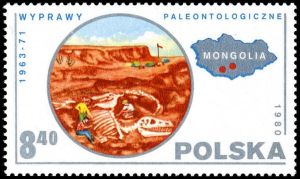
Some
details about these expeditions can be found on PALAEONTOLOGIA
POLONICA web site (monograph series published by the
Institute of Palaeobiology of the Polish Academy of Sciences )
The
stamp on the right side is from Polish expedition set, issued in
1980 shows excavation of a dinosaur, perhaps Tarbosaur bataar, by
Polish paleontologist in Gobi desert.
All
of these animals, deoicted on this stamps, lived at the end of the Mesozoic Era, in the late
Cretaceous period (ca. 70 millions years ago). Their skeletons can be
seen in the Museum of Evolution in Warsaw (PKiN), and natural size
reconstructions in the Silesian Zoological Garden in Chorzow.
 PLN
0.70 - Saurolophus
- duck-billed dinosaur of the length of 15m. It
chewed plants with numerous small teeth at the end of the
jaw (the front was covered with a horn beak). It had a characteristic
bone outgrowth and maybe a skin balloon used for nuptial shows and
making sounds. PLN
0.70 - Saurolophus
- duck-billed dinosaur of the length of 15m. It
chewed plants with numerous small teeth at the end of the
jaw (the front was covered with a horn beak). It had a characteristic
bone outgrowth and maybe a skin balloon used for nuptial shows and
making sounds.
|
 PLN
0.70 - Gallimimus-
the biggest (ca. 5 m length) representative of (PAN),
at the cooperation with the Mongolian paleonthologist, dinosaurs
similar to ostrich: no teeth, long legs, and long necks, predatory;
Ornithischians. It was the most numerous dinosaur living in the
Jurassic Park. It was described and named by Polish scientists:
Professor Ewa Roniewicz and Halszka Osmolska from the Paleobiology
Department at the Polish Academy of SciencesRinczen Barsbolden. PLN
0.70 - Gallimimus-
the biggest (ca. 5 m length) representative of (PAN),
at the cooperation with the Mongolian paleonthologist, dinosaurs
similar to ostrich: no teeth, long legs, and long necks, predatory;
Ornithischians. It was the most numerous dinosaur living in the
Jurassic Park. It was described and named by Polish scientists:
Professor Ewa Roniewicz and Halszka Osmolska from the Paleobiology
Department at the Polish Academy of SciencesRinczen Barsbolden. |
 PLN
0.80 - Saichania
- representative of armoured dinosaurs, plant-eaters, of
its body covered with raised bony plates and equipped with a
dangerous club-like tail. It had an excellently shaped skin system of
the armour in the front part of the body. It was discovered by Polish
expeditions and described by doc. Teresa
Maryanska from the Museum of Earth of PAN. PLN
0.80 - Saichania
- representative of armoured dinosaurs, plant-eaters, of
its body covered with raised bony plates and equipped with a
dangerous club-like tail. It had an excellently shaped skin system of
the armour in the front part of the body. It was discovered by Polish
expeditions and described by doc. Teresa
Maryanska from the Museum of Earth of PAN. |
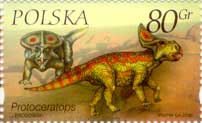 PLN
0.80 - Protoceratops -
very popular in numerous uncovered
rocks from the Cretaceous period in Mongolia and China. A primitive
horny dinosaur resembling its
bigger cousins (e.g. triceratops) with the bony collar at the rear of
the head and a curvy beak. The four-leg plant eater was 2 m long. It
lived in herds in dry, desert places. PLN
0.80 - Protoceratops -
very popular in numerous uncovered
rocks from the Cretaceous period in Mongolia and China. A primitive
horny dinosaur resembling its
bigger cousins (e.g. triceratops) with the bony collar at the rear of
the head and a curvy beak. The four-leg plant eater was 2 m long. It
lived in herds in dry, desert places. |
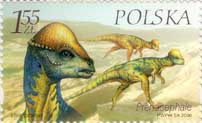 PLN
1.55 - Prenocephale -
the first representative of thick-head dinosaurs
(pachycefalosaurus) discovered outside North America.
Thickened bones at the top of the skull probably protected the small
brain during horning the heads during nuptial fights. The dinosaur was
almost 2m long. It was described by doc. Teresa Maryanska and Professor
Halszka Osmolska. PLN
1.55 - Prenocephale -
the first representative of thick-head dinosaurs
(pachycefalosaurus) discovered outside North America.
Thickened bones at the top of the skull probably protected the small
brain during horning the heads during nuptial fights. The dinosaur was
almost 2m long. It was described by doc. Teresa Maryanska and Professor
Halszka Osmolska. |
 PLN
1.55 - Velociraptor-
known, e.g., from the film Jurassic Park. An
agile predatory dinosaur from the group of
dromesaurs, of the body length of almost 2m, it was a close relative of
birds. Velociraptor attached its victim with characteristic claws in
its legs. PLN
1.55 - Velociraptor-
known, e.g., from the film Jurassic Park. An
agile predatory dinosaur from the group of
dromesaurs, of the body length of almost 2m, it was a close relative of
birds. Velociraptor attached its victim with characteristic claws in
its legs.
|
Products
FDC
(Skeleton of Saurolophus
, Protoceratops ,
and Velociraptor shown on illustration of FDC covers,
Velociraptor skull is on the postmark) |
Some
used covers |
|
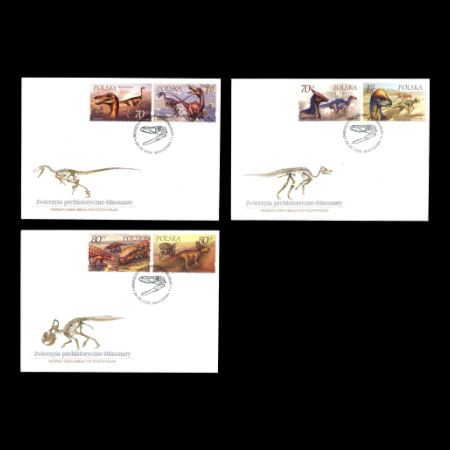
|

|
| Mini
Sheet |
Stamp
Sheets |
|

|
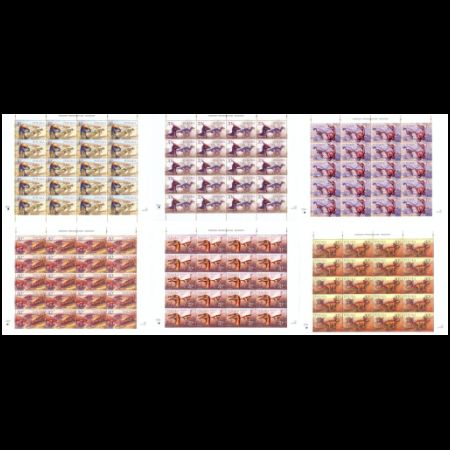
|
|
|
|
|
References:
Poczta Polska
Latest
update 23.11.2017
Any feedback, comments or even complaints
are welcome: [email protected] (you
can email me on ENglish, DEutsch, or RUssian)












